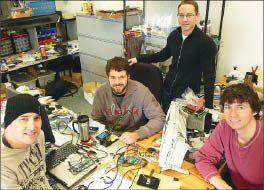
Home » Startup seeks to put 'touch' into touch screens
Startup seeks to put 'touch' into touch screens
HapticTouch technology provides tactile response akin to keyboards

February 26, 2009
Pacinian Corp., a Spokane startup, believes it's at the cusp of a breakthrough that users of cell phones and other computing devices will love to get their fingers on.
"It's like black magic," says Jim Schlosser, Pacinian's CEO. "We're tricking the mind. It feels like pushing down on a button, but you're not."
Pacinian is developing technology in the genre of "haptics," which refers to the science of touch and how the brain perceives touch, Schlosser says. The young company has branded its version of that technology as HapticTouch, and hopes this year to begin selling it to manufacturers of everything from smart phones to desktop computers.
The idea is to create a computer-like screen that, when a user touches it to activate a button or make a keystroke, the tactile response he or she feels is close to that of the sensation of pressing a key on a traditional keyboard.
Other tactile-response touch-screen technology already exists on the market, including that used in the highly touted Blackberry Storm smart phone, but Schlosser says Pacinian will improve on that technology by making the tactile sensation more like that of a keyboard.
The Storm, he contends, provides tactile feedback by placing a metal dome-like piece under the screen, as with a microwave keypad, so that when it's touched the user feels the sensation of pressure resistance. That technology, he says, requires about 200 to 300 grams of pressure to activate, making it more difficult to make rapid keystrokes, such as for text messaging.
"One of the complaints with that technology is it is too hard to click the screen," says Cody Peterson, Pacinian's chief technology officer.
Schlosser declines to disclose the technology used in HapticTouch, but claims its technology requires only 60 grams of pressure, or about the same as a mechanical keyboard. The actuator under the HapticTouch screen not only requires less force to depress for the users to get a tactile feedback from the device, but users can adjust how they want it to feel.
"It senses the finger is there, and they can push very lightly," says Peterson.
The tactile feedback is experienced precisely at the user's point of contact with the touch screen, rather than through the entire device, as is the case with popular feedback response technology used in such things as video game controllers, though HapticTouch also could provide repeating force feedback responses for such games and for scrolling functions, Schlosser says.
Pacinian, which operates in just 600 square feet of leased space in the Sirti Building, on the Riverpoint Campus, consists of four, 20- and 30-something-year-old engineers. It was founded and is co-owned by Schlosser and Peterson. The other two employees are Andy Huska, who specializes in electrical design, and Doug Krumpelman, who specializes in mechanical design.
The company was launched in April 2008, and received about $800,000 in loans from angel investors, plus a $350,000 loan in December from the Sirti Technology Growth Fund, which is designed to accelerate the growth of technology companies that do not qualify for conventional bank financing.
Peterson named the company after one of the primary mechanoreceptors in the fingers used to sense touch.
Schlosser says Pacinian has been working on its HapticTouch technology for 18 months, and hopes to have a "kit" ready for interested electronics manufacturers within six to nine months. He anticipates the technology could be available to consumers in electronics devices in 12 to 15 months.
John Overby, Sirti's client services director, says, "Pacinian's technology appears to be the most fundamental breakthrough in keyboard technology in the past 20 years."
Overby founded Advanced Input Devices, a Coeur d'Alene-based keyboard manufacturing company now called Advanced Input Systems.
"They (Pacinian) have great market potential because their technology will apply equally to personal computing devices as well as any flat screen hand-held device," Overby says.
Johnny Humphreys, former CEO of Itron Inc. and a Pacinian board member, says, "With the competitive environment that consumer electronics companies are facing, we believe Pacinian is well positioned to help the companies that adopt their technology create new value and drive consumer demand. Whenever there is a monumental leap in technology that the consumer wants they tend to find a way to purchase it even in the most difficult of economic times."
Pacinian's target customers are global manufacturers that provide personal computing devices to consumer electronics makers like Apple Inc. and Hewlett-Packard Development Co.
Such companies could put HapticTouch into virtually any touch-centric device, with touch screens ranging in size from 3 inches in diameter to 20 inches, Schlosser says.
"The first customer to adopt our technology will gain a competitive advantage by providing a differentiated product that makes the user experience more satisfying," he says.
"There are touch-screen-based handset devices in the industry today that do provide tactile feedback," says Schlosser. "However, Pacinian's haptic kit provides a confirming response that feels more like a mechanical key, and users can personalize how they want their response to feel."
Latest News
Related Articles



